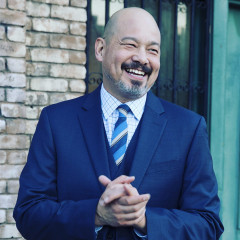Entertainment Spotlight
Actor Tim Lounibos - Hopeful Opportunities Ahead for APA's in Hollywood Movies and Television
Forbidden City Painting Makes U.S. Museum Debut
An 18th Century Forbidden City Painting Makes Its U.S. Museum Debut after being privately held for 100 years.
SALEM, Mass.An exquisite 18thcentury Chinese painting receives its American museum debut September 23 when the Peabody Essex opens The Emperor Looks West, an installation of imperial art from the Qianlong era. The painting, measuring 20 inches high and 19 feet long, in the traditional hand scroll format, was created for the Qianlong emperor, who ruled China for 60 years. "Victory Banquet at the West Garden is remarkable for its vivid color and extraordinary detail, and gives a glimpse of a once closed part of Chinese societythe Forbidden Cityhome of Chinese emperors for 500 years. The scroll painting, on loan to the Peabody Essex Museum, is being exhibited publicly after a century of private ownership in France. (The scroll once belonged to the family of former French President, Paul Doumer.) The exhibition includes more than 20 other objectsfrom a dazzling European-style clock and a Mughal-style jade bowl to ceramics, enamels and cloisonnreflecting the range of international influences that helped shape imperial art during Qianlongs rule. The Emperor Looks West opens Sept. 23, 2006, and runs through April 30, 2007.
While Chinese culture once captured the imagination of Western art enthusiasts, creating the rage of Chinoiserie, this exhibition shows that the attraction went both ways, says Nancy Berliner, curator of Chinese art. The rulers of 18th century China were equally intrigued with styles coming from Chinas west, including Central Asia and Europe, and they commissioned exceptionally fine works of art reflecting their fascination with those foreign styles.
The scroll, painted in ink, mineral-based color, and gold on silk, by court painters Zhang Tingyan and Zhou Kun, depicts Qianlong as the focus of a ceremony marking a military victory in a region in western China. We see that the emperor has arrived by water; there is an image of an imperial barge with a throne on the upper deck, and a bridge that crosses the lake is shown in the distance. The emperor is carried by servants on a palanquin toward a large white Mongolian-style yurt, the round, felt tent used traditionally by nomads in Central Asia. Richly patterned rugsalso adopted from Central Asian culturesmark the entrance of the structure. Officials, representatives and members of the imperial family are kneeling on both sides of the walkway. Shades of blue, red, and imperial yellow against a background of delicately painted trees are the predominant colors of this section of the scroll.
The fine brush strokes detailing the intricacies of this elaborate scene identify it not only as a work describing the grand life within the palace walls, but also as one of the great artworks created under the direction of the Qianlong emperor. Naturalism in art, perspective, trompe-loeil, as well as tapestries, architecture and the mechanics of clocks and copper engravings, were all aspects of European, Central Asian and Indian art and culture that the emperor encouraged his artists to incorporate into their creations, examples of which are included in this exhibition.
Visitors to The Emperor Looks West will also enjoy Inspired by China: Contemporary Furnituremakers Explore Chinese Traditions, which opens Oct. 28, 2006. Organized by PEM, the show brings together 29 stellar examples of historic Chinese furniture, with 28 new works made specifically for the exhibition. Inspired by China is a fascinating look at contemporary innovations in furnituremaking from the perspective of timeless Chinese furniture design.
About the Peabody Essex Museum
The recently transformed Peabody Essex Museum presents art and culture from New England and around the world. The museum's collections are among the finest of their kind, showcasing an unrivaled spectrum of American art and architecture (including four National Historic Landmark buildings) and outstanding Asian, Asian Export, Native American, African, Oceanic, Maritime, and Photography collections. In addition to its vast collections, the museum offers a vibrant schedule of changing exhibitions and public programs, plus a hands-on education center. In 2006, PEM was named one of the nation's Top 10 Art Museums for Kids by Child Magazine. The museum campus features numerous parks, period gardens, and 24 historic properties, including Yin Yu Tang, a 200-year old house that is the only example of Chinese domestic architecture in the United States. The Peabody Essex Museum is open daily, 10 a.m. to 5 p.m. The museum is closed Thanksgiving, Christmas, and New Year's Day. General museum admission: Adults $13; seniors $11; students $9 Additional admission to Yin Yu Tang: $4 Members, youth 16 and under, and residents of Salem enjoy free general admission and free admission to Yin Yu Tang. Special exhibitions may require an additional fee. Location: East India Square, Salem, MA 01970. Call 866-745-1876.
Website: http://www.pem.org


